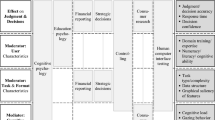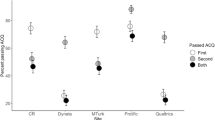Abstract
Trust allows people to live in a risky and uncertain situation by providing the means to decrease complexity. It is the key to decision making and engaging in usage. Visualizing trust information could thus leverage usage behavior and decisions. This article explores the impact of trust information visualization on mobile application usage with a three-stage experiment conducted in both Finland and China (1) by studying users’ opinions on the importance of mobile applications, (2) by evaluating the impact of a trust indicator on mobile application usage, and (3) by evaluating the impact of a trust/reputation indicator on mobile application usage. Although the results achieved in this study for Finland and China showed small differences on usage willingness and remarkable difference on trust information check willingness, both countries indicated that visualizing the reputation value of an application and/or the individual trust value of a user can assist in mobile application usage with different importance rates. In addition, the article discusses possible reasons for the difference in impact in Finland and China, other impact factors related to mobile application usage, and implications of our experiments with regard to a trust management system for mobile applications.







Similar content being viewed by others
References
Anderson JC, Narus JA (1990) A model of distributor firm and manufacturer firm working partnerships. Marketing 54(1):42–58
Antifakos S, Kern N, Schiele B, Schwaninger A (2005) Towards improving trust in context-aware systems by displaying system confidence. In: Proceedings of the 7th international conference on human computer interaction with mobile devices and services. ACM Press, New York, NY, pp 9–14
Artz D, Gil Y (2007) A survey of trust in computer science and the semantic web. Web Semantics: Science, Services and Agents on the World Wide Web 5(2)
Avizienis A, Laprie JC, Randell B, Landwehr C (2004) Basic concepts and taxonomy of dependable and secure computing. IEEE Trans Dependable Secure Comput 1(1):11–33
Awad N, Ragowsky A (2008) Establishing trust in Electronic commerce through online word of mouth: an examination across genders. J Manage Inf Syst 24(4):101–121
Baba ML, Falkenburg DR, Hill DH (1996) Technology management and American culture: implications for business process redesign. Res Technol Manage 39(6):44–54
Basso A, Goldberg D, Greenspan S, Weimer D (2001) Emotional and cognitive factors underlying judgments of trust e-commerce. In: Proceedings 3rd ACM conference on electronic commerce. ACM Press, New York, pp 137–143
Bhattacherjee A (2002) Individual trust in online firms: scale development and initial test. J Manage Inf Syst 19(1):211–241
Bickmore T, Cassell J (2001) Relational agents: a model and implementation of building user trust. Proc CHI 2001:396–403
Briggs P, Burford B, De Angeli A, Lynch P (2002) Trust in online advice. Social Sci Comput Rev 20(3):321–332
Corritore CL, Kracher B, Wiedenbeck S (2003) On-line trust: concepts, evolving themes, a model. Int J Human Comput Stud Trust Technol 58(6):737–758
Cramer H, Evers V, Ramlal S, Someren M, Rutledge L, Stash N, Aroyo L, Wielinga B (2008) The effects of transparency on trust in and acceptance of a content-based art recommender. User Model User Adap Inter 18(5):455–496
Denning DE (1993) A new paradigm for trusted systems. In: Proceedings of the 1992–1993 workshop on new security paradigms
Deutsch M (1960) Trust, trustworthiness, and the F Scale. J Abnorm Soc Psychol 61(1):138–140
Deutsch M (1973) The resolution of conflict: constructive and destructive processes. Yale University Press, New Haven
Dunn JR, Schweitzer ME (2005) Feeling and believing: the influence of emotion on trust. J Pers Soc Psychol 88(5):736–748
Fishbein M, Ajzen I (1975) Beliefs, attitude, intention and behavior: an introduction to theory and research. Addison-Wesley, Reading, MA
Fogg BJ, Marshall J, Kameda T, Solomon J, Rangnekar A, Boyd J, Brown B (2001) Web credibility research: a method for online experiments and early study results. In: Proceedings of CHI2001, extended abstracts. ACM Press, New York, pp 295–296
Fogg BJ, Marshall J, Laraki O, Osipovich A, Varma C, Fang N, Paul J, Rangnekar A, Shon J, Swani P, Treinen M (2001) What makes web sites credible? A report on a large quantitative study. In: Proceedings of CHI2001. ACM Press, New York, pp 61–68
Fogg BJ (2002) Persuasive technology: using computers to change what we think and do. Morgan Kaufman, San Francisco
Fox A (1974) Beyond contract: work, power, and trust relations. Faber, London, UK
Grandison T, Sloman M (2000) A survey of trust in internet applications. IEEE Commun Surv 4th Quart 3(4):2–16
Herlocker JL, Konstan JA, Riedl J (2000) Explaining collaborative filtering recommendations. In: Proceedings of the 2000 ACM conference on computer supported cooperative work. ACM Press, New York, pp 241–250
Huang H, Keser C, Leland J, Shachat J (2003) Trust, the Internet and the digital divide. IBM Syst J 42(3):507–518
Karvonen K (2001) Designing trust for a universal audience: a multicultural study on the formation of trust in the internet in the Nordic countries. In: Stephanidis C (ed) First international conference on universal access in human-computer interaction, vol 3. Erlbaum, Mahwah, NJ, pp 1078–1082
Kim J, Moon JY (1997) Designing towards emotional usability in customer interfaces-trustworthiness of cyber-banking system interfaces. Interact Comput 10:1–29
Kim J, Moon J (1998) Designing towards emotional usability in customer interfaces: trustworthiness of cyber-banking system interfaces. Interact Comput 10:1–29
Lee KC, Chung N (2009) Understanding factors affecting trust in and satisfaction with mobile banking in Korea: a modified DeLone and McLean’s model perspective. Interact Comput 21(5–6):385–392
Lee J, Kim J, Moon JY (2000) What makes internet users visit cyber stores again? Key design factors for customer loyalty. In: Proceedings of CHI2000. ACM press, New York, pp 305–312
Lee J, Moray N (1992) Trust, control strategies and allocation of function in human-machine systems. Ergonomics 35(10):1243–1270
Liu Z, Joy AW, Thompson RA (2004) A dynamic trust model for mobile ad hoc networks. In: Proceedings of the 10th IEEE international workshop on future trends of distributed computing systems (FTDCS 2004), pp 80–85
Lohse GL, Spiller P (1998) Electronic shopping. Commun ACM 41(7):81–87
Lumsden J, MacKay L (2006) How does personality affect trust in B2C e-commerce? In: Proceedings 8th international conference on electronic commerce: the new e-commerce: innovations for conquering current barriers, obstacles and limitations to conducting successful business on the internet. ACM Press, New York, NY, pp 471–481
McCrickard DS, Czerwinski M, Bartram L (2003) Introduction: design and evaluation of notification user interfaces. Int J Hum Comput Stud 58(5):509–514
McKnight DH, Chervany NL (2001) Trust and distrust definitions: one bite at a time. In: Falcone R, Singh M, Tan Y-H (eds) Trust in cyber-societies. Springer, Berlin
McKnight DH, Choudhury V, Kacmar C (2002) Developing and validating trust measures for e-commerce: an integrative typology. Inf Syst Res 13(3):334–359
Mui L (2003) Computational models of trust and reputation: agents, evolutionary games, and social networks. Doctoral dissertation, Massachusetts Institute of Technology, 2003
Muir BM (1987) Trust between humans and machines, and the design of decision aids. Int J Man Mach Syst 27:527–539
Muir BM (1994) Trust in automation part I: theoretical issues in the study of trust and human intervention in automated systems. Ergonomics 37(11):1905–1922
Muir BM, Moray N (1996) Trust in automation part II: experimental studies of trust and human intervention in a process control simulation. Ergonomics 39(3):429–469
Nielsen J (1999) Trust or bust: communicating trustworthiness in Web design. http://www.useit.com/alertbox/990307.html
Nielsen J, Molich R, Snyder S, Farrell C (2000) E-commerce user experience: trust. Nielsen Norman Group
Olson JS, Zheng J, Bos N, Olson GM, Veinott E (2002) Trust without touch: jumpstarting long-distance trust with initial social activities. In: Proceedings of CHI2002, pp 141–146
PhoneScreen: http://wikis.in.nokia.com/AlphaLabs/PhoneScreen
Pu P, Chen L (2007) Trust-inspiring explanation interfaces for recommender systems. Knowl Based Syst 20(6):542–556
Riegelsberger J (2003) Interpersonal cues and consumer trust in e-commerce. In: Proceedings of CHI2003, extended abstracts, ACM press, New York, pp 718–719
Riegelsberger J, Sasse MA (2001) Trust builders and trustbusters: the role of trust cues in interfaces to E-commerce applications. In: Towards the E-society: proceedings of the first IFIP conference on E-commerce, E-society, and E-Government, pp 17–30
Riegelsberger J, Angela Sasse M, McCarthy JD (2005) Do people trust their eyes more than ears? Media bias in detecting cues of expertise. In: Proceedings of CHI2005. ACM Press, New York, pp 1745–1748
Riegelsberger J, Sasse AM, McCarthy JD (2005) The mechanics of trust: a framework for research and design. Int J Hum Comput Stud 62(3):381–422
Riley V (1996) Operator reliance on automation: theory and data. In: Parasuraman R, Mouloua M (eds) Automation and human performance: theory and applications. Lawrence Erlbaum Associates, Mahwah, New Jersey, pp 19–36
Rukzio E, Hamard J, Noda C, Luca AD (2006) Visualization of uncertainty in context aware mobile applications. In: Proceedings of mobile HCI. ACM Press, New York, NY, pp 247–250
Schechter SE, Dhamija R, Ozment A, Fischer I (2007) The emperor’s new security indicators. In: Proceedings of 2007 IEEE symposium on security and privacy, pp 51–65
Shelat B, Egger FN (2002) What makes people trust online gambling sites? In: Proceedings of CHI2002, extended abstracts. ACM Press, New York, pp 852–853
Sheppard BH, Hartwick J, Warshaw PR (1988) The theory of reasoned action: a meta analysis of past research with recommendations for modifications in future research. Consumer Res 15(3):325–343
Sheridan T (1980) Computer control and human alienation. Technol Rev 83:61–73
Sillence E, Briggs P, Harris P, Fishwick L (2006) A framework for understanding trust factors in web-based health advice. Int J Hum Comput Stud 64(8):697–713
Steinbrück U, Schaumburg H, Duda S, Kruger T (2002) A picture says more than a thousand words—photographs as trust builders in e-commerce websites. In: Proceedings of CHI2002, extended abstracts. ACM Press, New York, pp 748–749
Tan FB, Sutherland P (2004) Online consumer trust: a multi-dimensional model. J Electron Commer Org (JECO) 2(3):40–58
Venkatesh V, Davis FD (2000) A theoretical extension of the technology acceptance model: four longitudinal field studies. Manage Sci 46(2):186–204
Wang YD, Emurian HH (2005) An overview of online trust: concepts, elements and implications. Comput Hum Behav 21:105–125
Yamagishi T, Yamagishi M (1994) Trust and commitment in the United States and Japan. Motiv Emot 18:129–166
Yan Z (2007) Trust management for mobile computing platforms. Dissertation, Helsinki University of Technology
Yan Z (2010) Trust modeling and management in digital environments: from social concept to system development. IGI Global. doi:10.4018/978-1-61520-682-7
Yan Z, Dong Y, Niemi V, Yu GL (2009) Exploring trust of mobile applications based on user behaviors. InTrust 2009. LNCS 6163:212–226
Yan Z, Holtmanns S (2008) Trust modeling and management: from social trust to digital trust. In: Subramanian R (ed) Computer security, privacy and politics: current issues, challenges and solutions. IGI Global
Yan Z, Niemi V (2009) A methodology towards usable trust management. Proc Auton Trust Comput ATC09, LNCS 5586:179–193
Yan Z, Yan R (2009) Formalizing trust based on usage behaviours for mobile applications. Proc ATC09 LNCS 5586:194–208
Yan Z, Zhang P, Deng RH (2012) TruBeRepec: a trust-behavior-based reputation and recommender system for mobile applications. Pers Ubiquit Comput 16(5):485–506. doi:10.1007/s00779-011-0420-2
Zimmerman J, Kurapati K (2002) Exposing profiles to build trust in a recommender. In: Proceedings of CHI2001, extended abstracts. ACM Press, New York, pp 608–609
Zuboff S (1988) In the age of the smart machine. Basic Books, New York
Acknowledgments
This work is supported by the Fundamental Research Funds for the Central Universities under Grant K5051201032. The authors would like to thank Prof. Rong Yan’s coordination and help on the work described in this article.
Author information
Authors and Affiliations
Corresponding author
Rights and permissions
About this article
Cite this article
Yan, Z., Liu, C., Niemi, V. et al. Exploring the impact of trust information visualization on mobile application usage. Pers Ubiquit Comput 17, 1295–1313 (2013). https://doi.org/10.1007/s00779-013-0636-4
Received:
Accepted:
Published:
Issue Date:
DOI: https://doi.org/10.1007/s00779-013-0636-4




